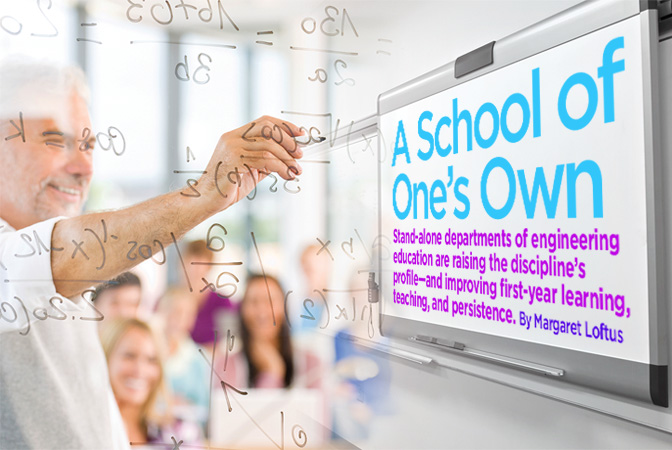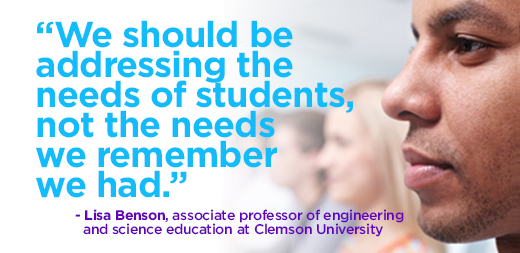A School Of One’s Own
Holly Matusovich worked as a metallurgical engineer until a particularly stressful long-term assignment prompted her to reassess her career and explore education. It took just a few classes at Purdue University’s School of Engineering Education to make her want to plunge in and become an expert on motivation and learning. “When I got involved in my first research project, it was the coolest thing ever,” recalls Matusovich, one of the nascent department’s earliest Ph.D. candidates. “I absolutely loved it.” Now an assistant professor at Virginia Tech’s Department of Engineering Education, she is intent on making engineering more accessible to students.
Educators have long agreed that rethinking the traditional “chalk and talk” style of teaching is essential if engineering colleges hope to attract, retain, and train a larger, more diverse group of students. Until recently, schools mostly took a scattershot approach. But in the past decade, many have embraced engineering education as a stand-alone discipline, applying research and multidisciplinary scholarship to transform teaching by reconfiguring classrooms, fostering collaboration, and using interactive tools. A few pioneers – at Purdue, Virginia Tech, Utah State University, and Clemson University – have established separate schools or departments dedicated to the discipline.
The emergence of engineering education departments marks a major milestone in a decades-long struggle to bring fresh ideas to the training of engineers while adhering to consistent standards – even as engineering itself keeps advancing. Momentum continues to build as schools respond to calls by industry and political leaders for a dramatic increase in engineering graduates. As one sign, ASEE’s 2002 annual conference had 17 sessions with “teaching” in the title; a decade later, that number had climbed to 100. “There’s a lot of knowledge and research out there,” explains David Radcliffe, the Kamyar Haghighi Head of Purdue’s School of Engineering Education, which will celebrate its 10th anniversary next year. “What we needed to do was develop across the country a critical mass of scholars whose research work was to add to the knowledge base about how engineers learn and help educate future faculty around those techniques.”
Several engineering schools now offer doctorates in engineering education. Others have launched centers that foster research in engineering curriculum design, such as Texas A&M’s new Institute for Engineering Education and Innovation. While proponents agree that these are all positive steps in the discipline’s evolution, having a distinct department with tenured professors bestows legitimacy. “A department is a beachhead,” says Radcliffe, noting that “when we started, nobody had ever gotten tenure in this discipline.” Having a recognized group of engineering education colleagues who teach courses and publish research also makes it easier to share and adopt evidence-based instructional methods. “You’re actually building communities of practice,” says Stephanie Adams, head of Virginia Tech’s engineering education department.
While their reach varies from school to school, engineering education departments have a common core mission: changing how freshmen are taught. “We train future generations to be excellent educators, and we happen to start by preparing them to teach first-year students,” says Adams. Except at Clemson, first-year engineering programs fall under the purview of engineering education departments. One major effort involves finding ways to enliven large introductory lecture classes – which research and retention rates suggest are a poor way to teach freshman – with engaging engineering experiences and applications. “The professor walks to the top of the classroom, and the expectation is that students will be sponges and take it all in,” says Kurt Becker, a Utah State professor of engineering education who recently stepped down as the department head. “We don’t give them enough engineering right out of the block, so as a profession we need to look at the way we’re training them.”
Start with the best
When Utah State launched its engineering education department in 2004, the school — which oversees first- and second-year coursework as well as a pre-engineering associate’s degree offered at four regional campuses — broke with tradition. It assigned top instructors, identified by outstanding track records, to freshman foundational classes. “We said, ‘Let’s put our best people in those classes or hire new people that will do a great job,’ ” Becker explains. Teachers may be reassigned if more than 10 percent of their students earn a D, fail, or withdraw (DFW). Engineering education faculty now are using these large, foundational courses to collect data and publish findings on new pedagogy and assessment strategies. They also have received state funding to develop and deliver foundational engineering courses online. “The word is out about our quality and going beyond the boundaries of our campus,” says Becker.
Engineering education departments also are helping to retrain faculty. Apart from the occasional workshop, most professors aren’t exposed to pedagogy and “are expected to teach with little or no training on how students learn,” says Lisa Benson, an associate professor of engineering and science education at Clemson. Originally a bioengineering professor, she switched fields after becoming interested in how her students developed problem-solving skills. Benson finds that as a default, instructors let their own student experiences inform their teaching. “We should be addressing the needs of students, not the needs we remember we had,” she concludes.
With this in mind, in 2006 Benson and her colleagues borrowed a student-centered method developed by science education researchers at North Carolina State University to flip the way calculus is typically taught. For starters, the classroom was redesigned to accommodate students around 7-foot round tables wired for laptop use, shifting the focus from the instructor to teams collaborating on problems. “Rather than the traditional approach, where 95 percent of the talking is done by the professor, the majority of talking is being done by students, and the majority of the students are engaged,” explains Benson. “Everyone is empowered.” The project posted a DFW rate of 5 percent in its first year, compared with 30 percent for lecture-based calculus sections. Since then, nearly all calculus classes have been taught using the student-centered approach, with similarly positive outcomes.
At Virginia Tech, Matusovich uses an interactive approach in her first-year introductory class called Engineering Exploration. Instead of walking students through problems with PowerPoint slides, she asks them to submit their answers anonymously using tablets loaded with
DyKnow software that lets them interact with each other and the instructor. She then chooses several responses to highlight on-screen, allowing students to see that there’s often more than one way to solve a problem. “I like to think of it as building a community,” says Matusovich, who notes that a sense of belonging helps freshmen persist in engineering. “They can see how they’re doing compared to their peers. Often they are so busy, they don’t get that.”
Purdue takes classroom redesign one step further with its i2i Learning Laboratory, a cluster of seven spaces configured to take students through the design process. There’s a media-rich design studio room framed by a wall-to-ceiling whiteboard, where teams of freshmen test out ideas using tablet PCs, video projectors, and data acquisition equipment. The demonstration studio includes CAD stations and other technology for designing and simulating parts. Each component of the lab’s design, teaming, and learning technologies has been informed by engineering education research conducted by department faculty or other scholars. Since the lab’s introduction in 2009, the retention rate for freshmen has risen to 88 percent from around 78 percent.
K-12 research
Departments of engineering education also can be incubators for hybrid bachelor’s degrees that span disciplines or incorporate pedagogy. Purdue’s school, for example, offers a multidisciplinary engineering program that lets students design their own engineering major. At Virginia Tech, students who want to explore teaching practices can earn a certificate in engineering education to complement a bachelor’s degree in their major.
Beyond improving teaching and learning at the college level, engineering education departments figure prominently in research initiatives to boost K-12 engineering education. Virginia Tech, for example, has studied children in Appalachia and their obstacles and pathways into engineering. Purdue created INSPIRE – the Institute for P-12 Engineering Research and Learning – to research engineering habits of mind and practice in the precollege years. One project, for instance, finds new ways to provide professional development to third-, fourth-, and fifth-grade teachers who lack science backgrounds.
Such research demands different skills from those required in most other engineering disciplines. As Utah State’s Becker notes, while engineers typically take a quantifiable approach, “with humans, you can’t do that. We use mixed methods, which means qualitative and quantitative.” As a result, Ph.D. engineering education programs tend to attract students who are comfortable straddling the worlds of physical and social science. Department heads say they see less interest from newly minted graduates than from seasoned engineers who, like Matusovich, seek to redirect their careers. “You almost need to have some life experience to appreciate what we’re about,” says Purdue’s Radcliffe, adding that two thirds of his department’s students are women. That’s a dramatic departure from other engineering disciplines, where men outnumber women 5 to 1 on average.
Unlike students in many other doctoral programs, particularly in the social sciences, engineering education graduates enjoy robust job prospects. Though the number of Ph.D.’s remains small, the dozens who have earned a doctorate have gone on to assume first-year engineering leadership roles, conduct
postdoctoral research, and teach—often gravitating to innovative, multidisciplinary programs. (Just one Purdue engineering education Ph.D. ended up in industry.) Radcliffe and Adams, whose Virginia Tech department launched shortly after Purdue’s in 2004, envision a day when more of their grads go into industry, policy, and museums. Meanwhile, Matusovich is working on engaging the next generation of engineers. “I want students to have such great experiences that they set the bar higher for what they expect,” she says. “If we can set that bar, we can get top-down and bottom-up change going.”
ISTOCK PHOTO
Category: ASEE TODAY

